Physical Address
304 North Cardinal St.
Dorchester Center, MA 02124
Physical Address
304 North Cardinal St.
Dorchester Center, MA 02124
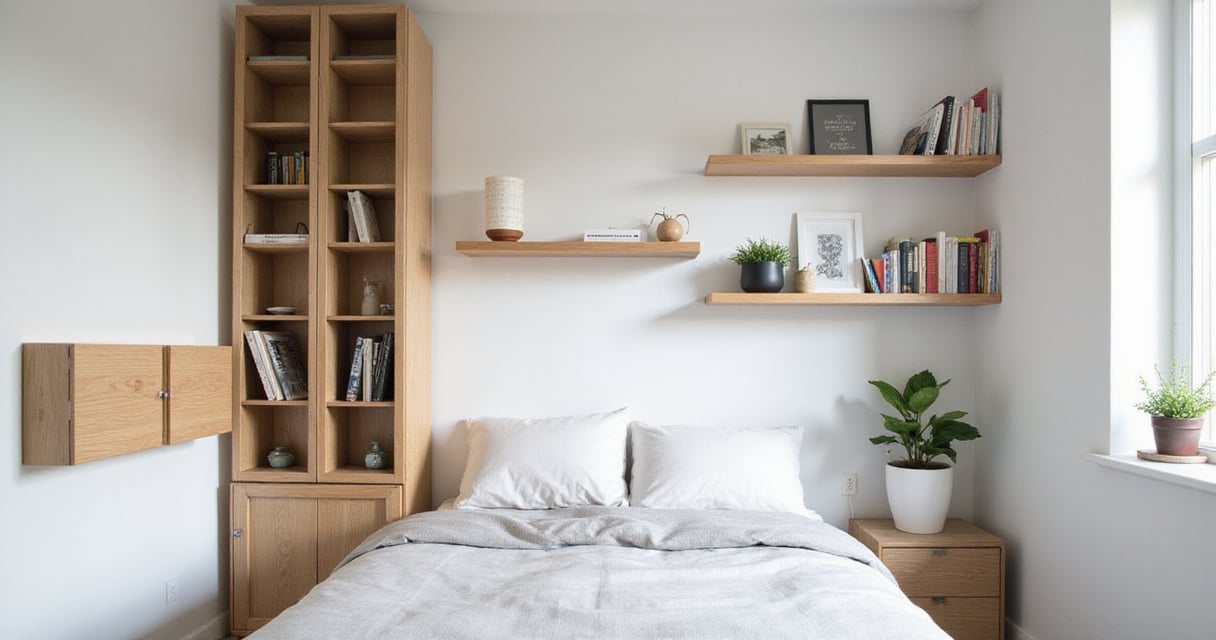
Transform your compact space with these 24 small bedroom decor ideas that maximize storage, create visual spaciousness, and turn your room into a peaceful sanctuary for rest and renewal.
Is your bedroom the one place you close the door on and sigh, not from relief, but from a feeling of being… crowded? If your small bedroom feels more like a storage unit you happen to sleep in than a true retreat, please know you’re in good company. I’ve seen it so many times. It can feel like you’re playing a losing game of Tetris with your own furniture, leaving you wondering where anything can possibly go.
But I want to offer you a different way to see it. A small bedroom isn’t a limitation; it’s an invitation to be truly intentional. It’s a chance to quiet the noise and decide what really matters. This is where my two worlds—meditation practice and interior design—beautifully overlap. When we approach our spaces with mindfulness, we don’t just organize a room. We create a sanctuary that holds us, supports our rest, and helps us reconnect with ourselves.
So let’s walk through this together. Here are 24 ideas I’ve gathered over my years of designing meditation rooms and calming spaces. They will help you transform your compact room into a peaceful haven that feels expansive, organized, and so deeply you.
When the floor is full, the only way to go is up. It’s a simple shift in perspective, but honestly, it changes everything. When we draw the eye upward with shelving or art, we’re not just clearing the floor; we’re creating a sense of lift and possibility. The room suddenly breathes.
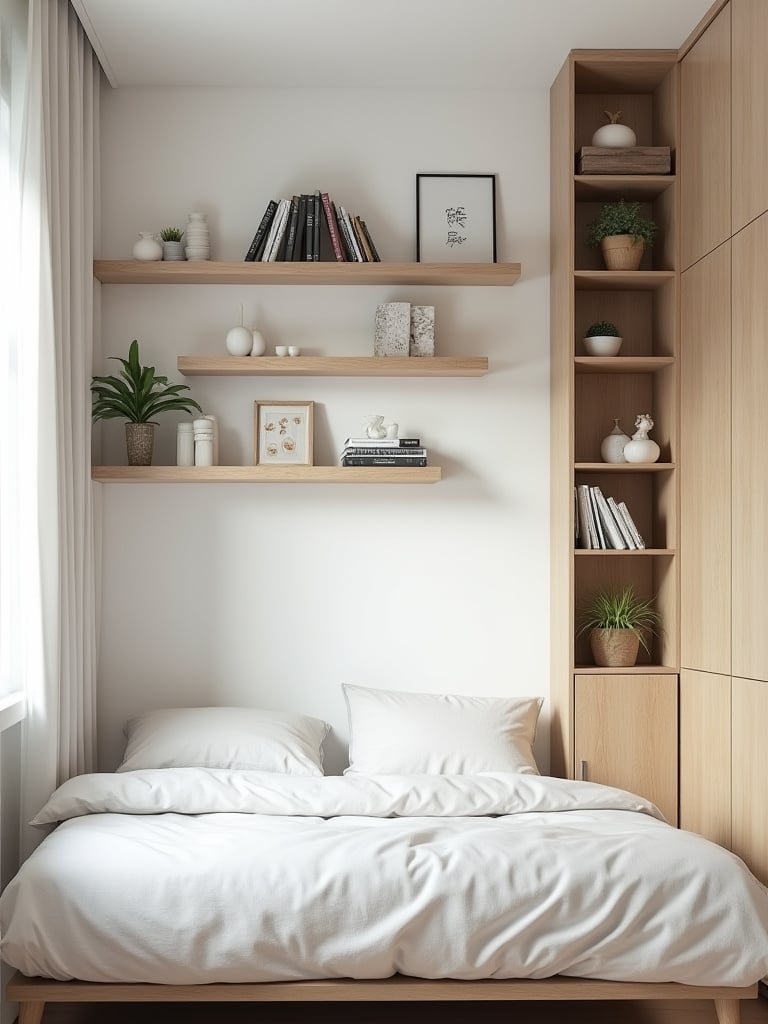
I remember a client in a city apartment whose bedroom was barely wider than her bed. She felt so constricted. We installed simple, tall, wall-mounted bookshelves on either side of her bed. It was like the walls suddenly fell away. What I tell my clients is that your walls are just floors tilted on their side—they hold just as much potential. Think floating shelves, wall-mounted cabinets, or even a beautiful pegboard system you can rearrange with your mood. The space above your bed or door is just waiting to be discovered.
Now that we’ve looked up, let’s look down to one of the most overlooked opportunities in any bedroom.
The area beneath your bed is like a hidden treasure chest. It’s this quiet, unassuming space that can hold all the things you need but don’t need to see every day—seasonal clothes, extra blankets, your yoga mat. Using this space frees up your visible room for peace and clarity.
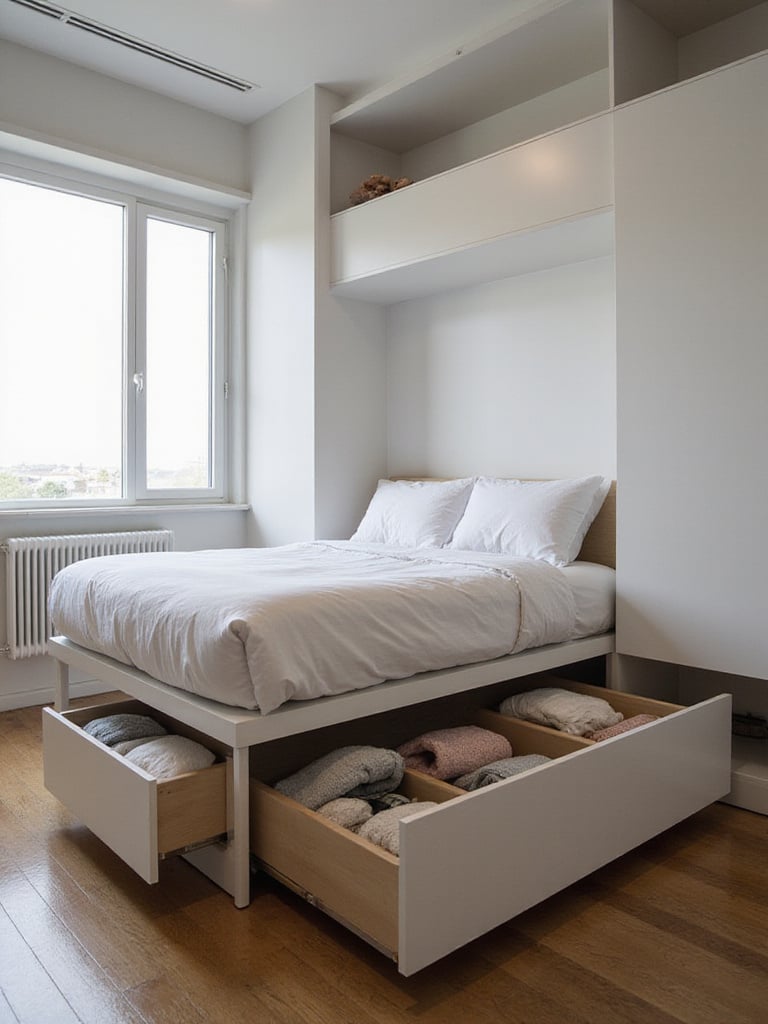
For maximum calm, try to avoid just shoving things under there. Investing in some simple, uniform containers makes a world of difference. I love fabric boxes with lids; they allow items to breathe and feel softer than hard plastic. Or, for bulky things like a winter duvet, vacuum-sealed bags are magic. I learned this when I first started living in smaller city apartments myself; the feeling of knowing everything had a home, even a hidden one, brought me so much peace at the end of the day.
This principle of thoughtful, hidden function is key. And it leads perfectly to making your storage a bit more visible, but in the most graceful way possible.
Floating shelves are one of my favorite tools for small spaces. They offer a place for your treasures without the visual weight of a bookcase or a nightstand. Their clean lines create an airy, uncluttered look that lets your mind rest.

You can use them to create a minimalist bedside surface for a cup of tea and a book, or a place to display a few cherished objects—that one beautiful stone from a memorable trip, a small plant, a framed photo. In my own meditation practice, I realized that seeing a few meaningful things, intentionally placed, is calming. A clutter of objects is agitating. A single floating shelf can be the perfect little altar for the things that bring you joy.
What makes them so special is how they honor both purpose and peace. It’s about surrounding yourself with what’s necessary or beautiful while leaving plenty of open space for your spirit to expand.
This might be an age-old design trick, but there’s a reason it has lasted: it works. Mirrors perform a kind of beautiful magic in a small room, bouncing light around and creating an illusion of depth that can instantly make a space feel more open and alive.
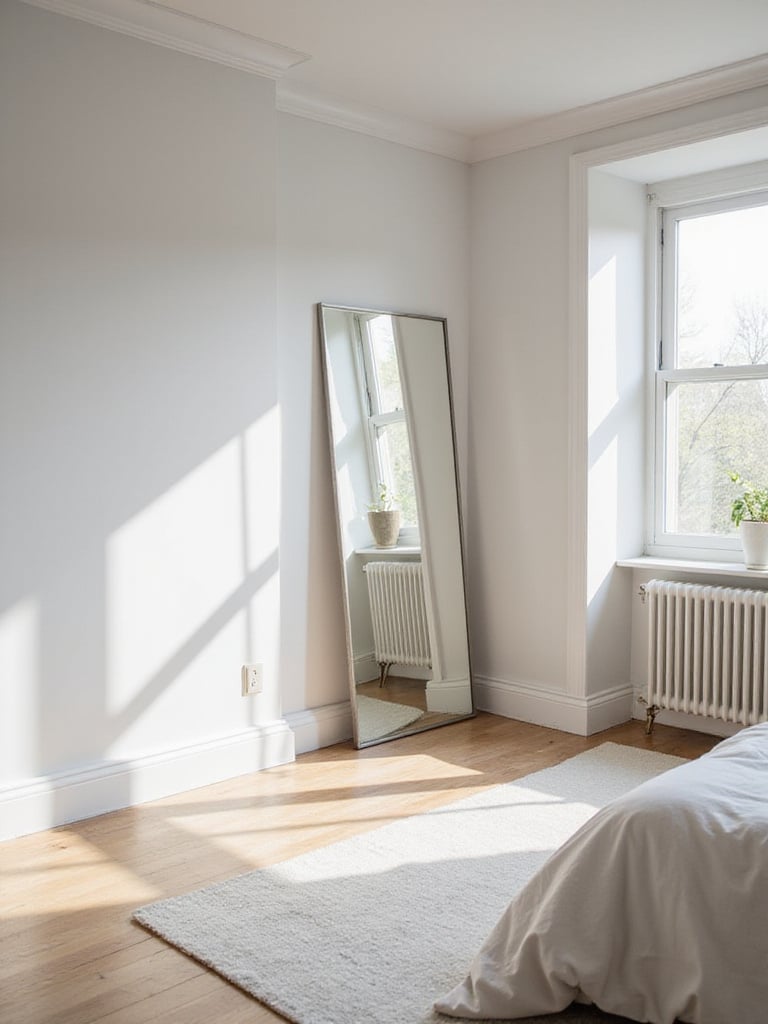
The key is placement. Don’t just hang a mirror anywhere. For a truly transformative effect, try positioning a large mirror directly opposite a window. It will capture the natural light and the view—I once did this in a client’s room that faced a single, beautiful maple tree, and it felt like we had brought the entire tree right into her room. A full-length mirror leaning against a wall also does double duty, helping you get ready while visually doubling the size of the floor space.
It’s not just about how the room looks, but how it feels. That sense of expansiveness can support deeper breathing and a calmer mind. It’s amazing what a little reflected light can do for the soul.
Color is energy. The colors that surround you have a profound effect on your mood and the feeling of a space. In a small room, light colors are your best friends. They are reflective, making walls seem to recede and creating an atmosphere of gentle openness.
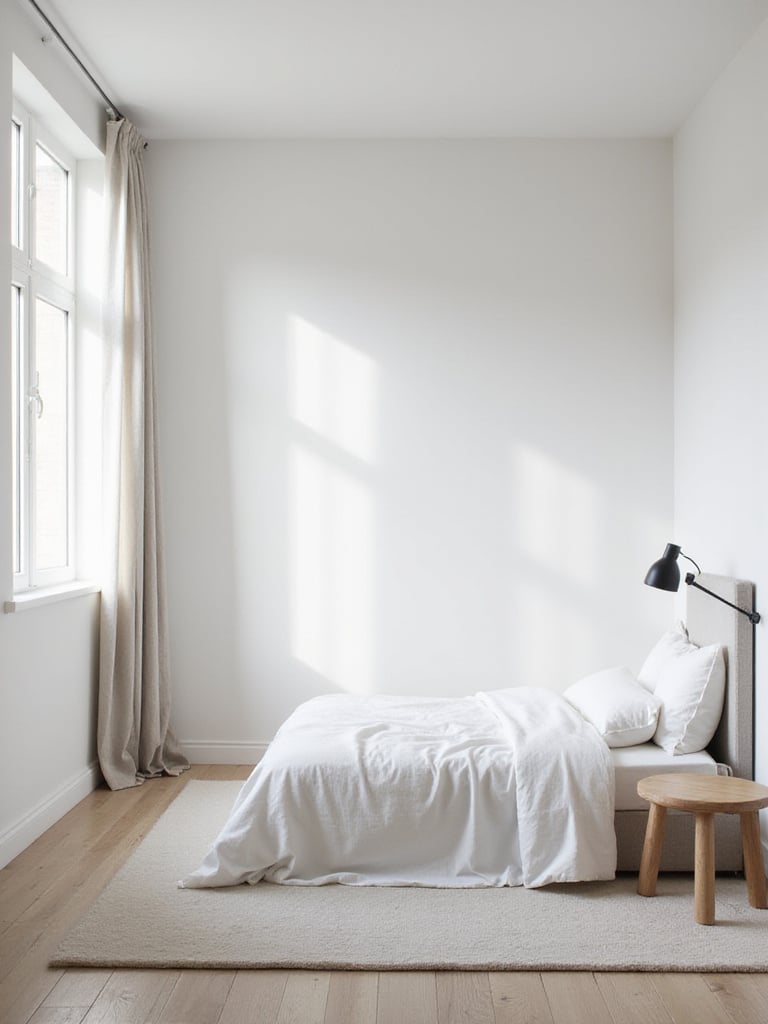
Think of soft whites, pale sage greens, or the gentle blue of a hazy morning sky. These colors are restful for the eyes and the spirit. Here’s a little trick I love: paint the ceiling the same color as the walls. This erases that hard line where the wall ends and the ceiling begins, making the entire room feel like a soft, seamless cocoon. Even the tiniest bedroom can feel expansive with the right color.
“Color is a power which directly influences the soul. Color is the keyboard, the eyes are the hammers, the soul is the piano with many strings.” – Wassily Kandinsky
He was so right. The colors you choose are the notes you play for your own soul each morning and night.
In a small bedroom, every piece of furniture should earn its keep. This is where investing in multi-functional pieces pays off, not just in square footage, but in mental clarity. One smart piece can do the work of two or three.
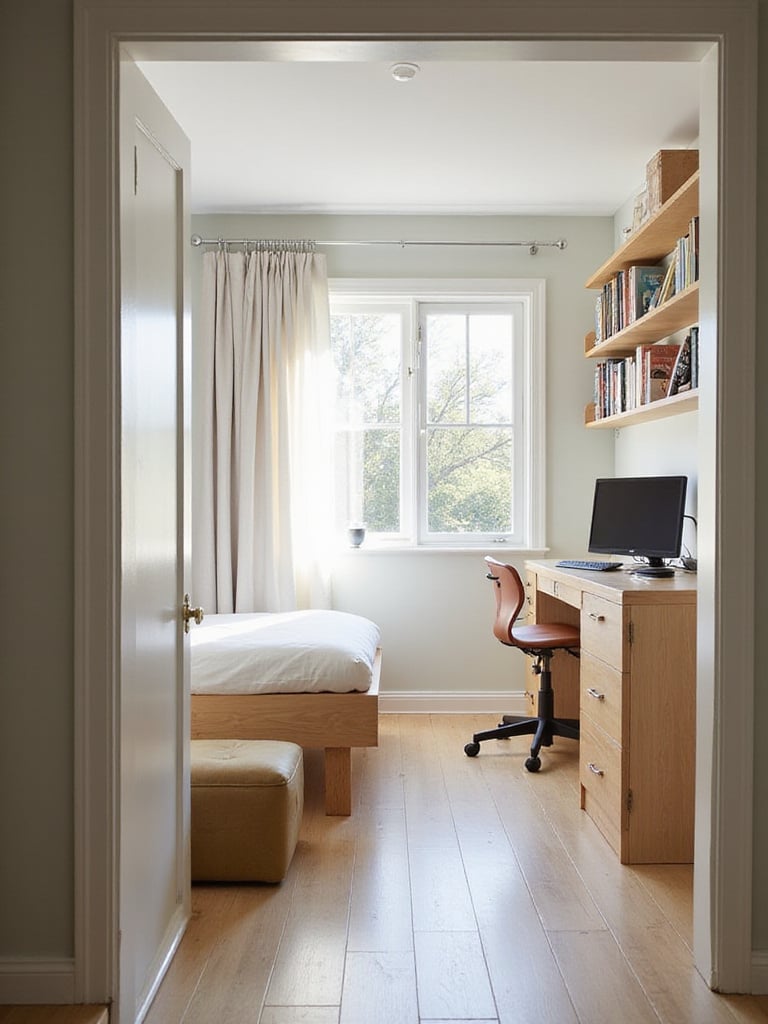
Look for a bed with built-in drawers underneath, a beautiful storage ottoman at the foot of your bed, or a headboard that has integrated shelving. I’ve seen some wonderfully clever desks that fold away into a slim console when you’re not working. From my work in mindful space design, I’ve found that clutter is one of the biggest sources of low-grade, constant stress. These thoughtful pieces help eliminate that stress by giving everything a home.
The real mindfulness practice here is taking a moment each evening to tuck the day away. Putting your laptop in its folded desk or your book onto its headboard shelf creates a ritual that signals to your mind: the day is done, it is time for rest.
So many of us need our bedroom to be more than just a place for sleep. If you need a small workspace or a spot to get ready, you don’t have to sacrifice your sense of calm. The answer is choosing furniture with a minimal, graceful footprint.
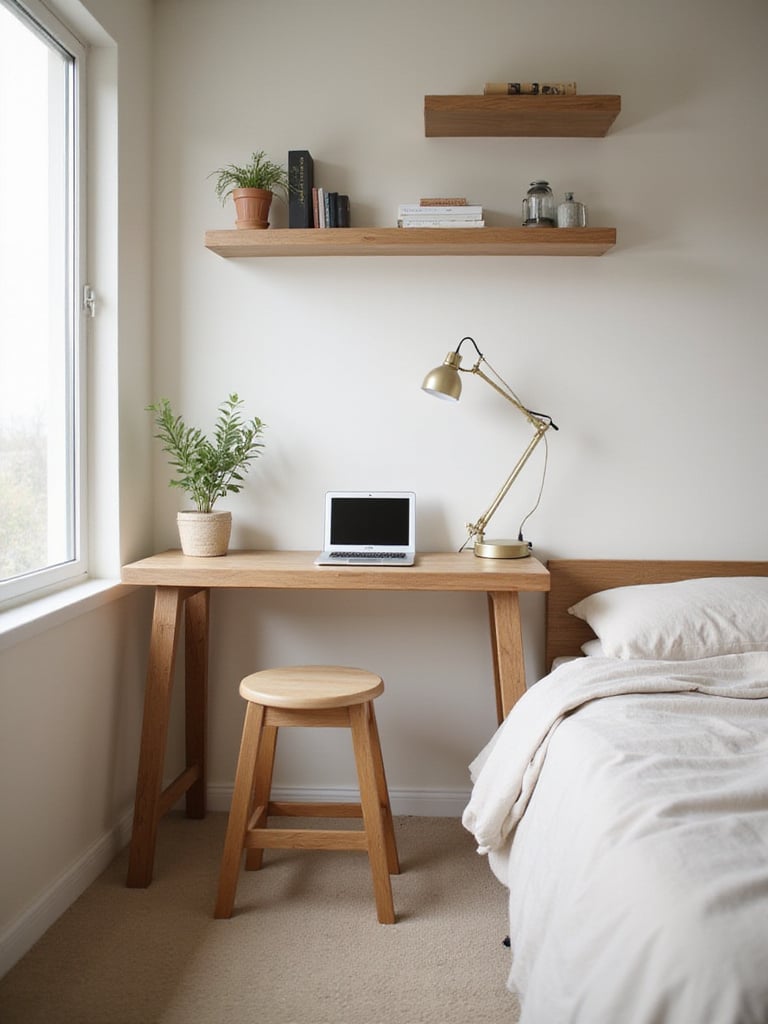
Look for a desk or vanity with a shallow depth—say, 15 inches instead of the standard 24. Wall-mounted “floating” desks are even better, as they keep the floor completely clear, which helps energy (and your vacuum cleaner!) flow more freely. These streamlined pieces give you the surface you need without visually overpowering the room.
What I’ve noticed is that these slimmer pieces force us to be more intentional. You can’t pile a month’s worth of papers on a shallow desk. It encourages you to keep only the essentials, which is a mindfulness practice in itself.
Lighting is so important for creating a warm, nurturing atmosphere. But a table lamp can eat up nearly all the space on a small nightstand. This is where wall sconces are a game-changer.

They free up that precious surface area while adding a touch of sophisticated, built-in style. Adjustable swing-arm sconces are fantastic for directing light right onto your book without disturbing a partner. And here’s the best part: so many beautiful designs are now plug-in, so you don’t need to call an electrician. You get the custom look without the hassle. I learned this when designing a meditation room for a client with no overhead lighting—a pair of dimmable sconces created the perfect, soft glow for evening practice.
Eliminating the visual clutter of lamp bases and cords creates a surprising amount of mental spaciousness. It’s a small change with a big return.
The wall right behind your bed is prime real estate that often goes completely unused. A headboard designed with integrated shelving or little cubbies transforms this spot into a powerhouse of function and style.
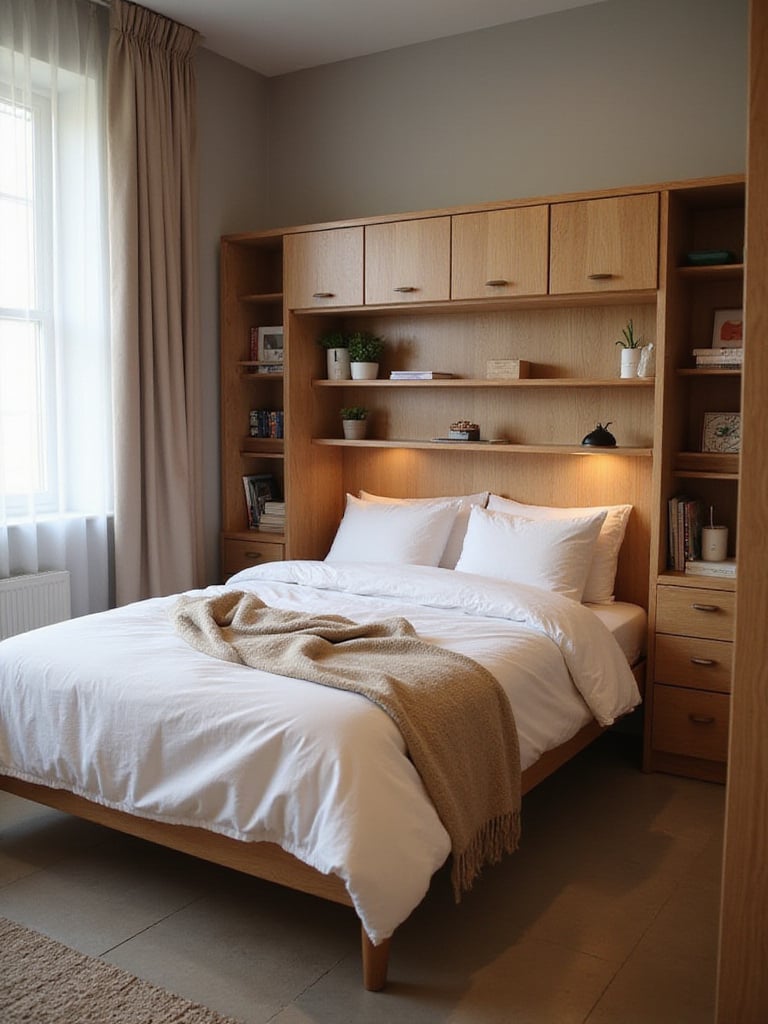
These clever headboards can replace a nightstand entirely, giving you a home for your reading glasses, your journal, a small vase of flowers, or a cup of herbal tea. You get to keep your essentials within arm’s reach without cluttering up a single horizontal surface. Some designs even have hidden compartments, which are perfect for tucking away things you want nearby but out of sight.
When clients ask me how to make a room feel custom and thoughtful, I often point to solutions like this. It shows you’re using every inch of your space with intention, which is the very heart of mindful design.
If a full storage headboard isn’t for you, here’s another way to achieve that light, airy feeling beside your bed. Swap out bulky, traditional nightstands for simple floating bedside tables. Essentially, they’re just small, elegant shelves.
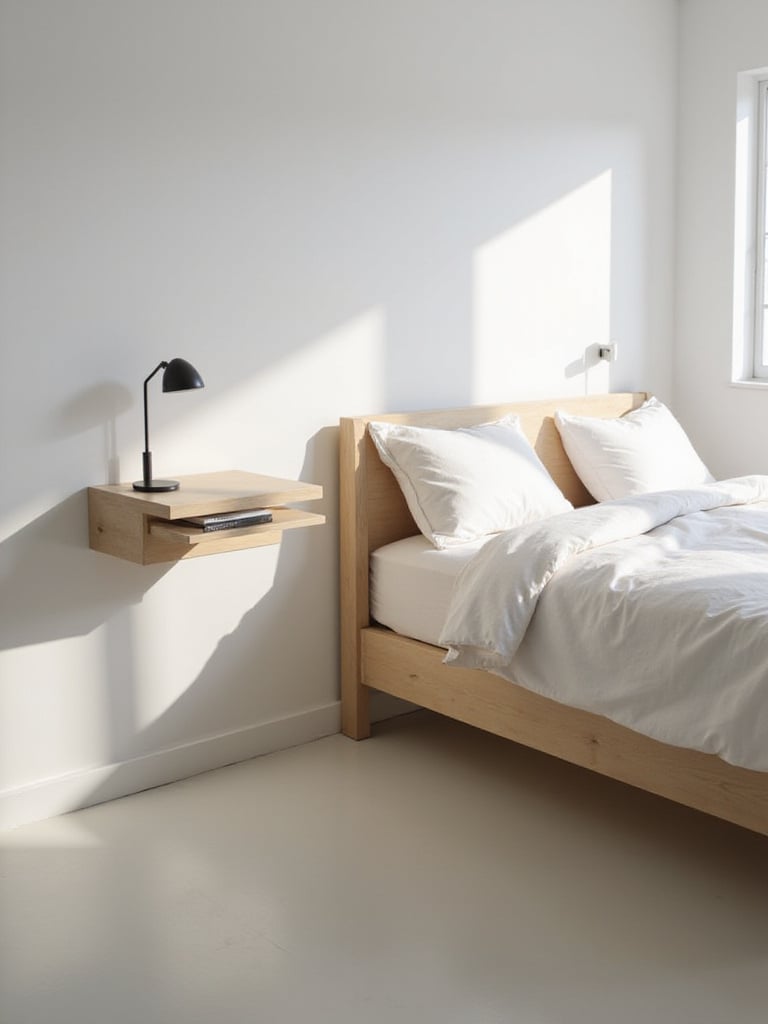
They give you just enough space for the essentials—your phone, a glass of water, a candle—without the visual heft of a four-legged table. Because they are mounted to the wall, the floor underneath remains open, which not only makes the room feel bigger but also makes cleaning so much easier. No more dust bunnies hiding behind nightstand legs!
What I love about this is the subtle message it sends: you only need what you truly need beside you when you sleep. It’s a built-in prompt for simplicity.
Okay, stay with me here. This is perhaps the most powerful strategy of all, and it costs absolutely nothing. Regular, gentle decluttering creates physical space, yes, but more importantly, it creates mental space. It’s a core practice in both mindful living and beautiful design.

Try to approach this not as a huge, daunting project, but as a small, recurring ritual. Maybe every Sunday morning, you take just 10 minutes to scan your room. Ask yourself: does this item support my rest and wellbeing? Do I truly love it, or is it just… here?
I see this with my meditation students all the time. The act of letting go of physical objects that no longer serve them creates a profound sense of inner lightness. Your bedroom is the perfect place to start.
This sounds so simple, but I promise you, it’s a revelation. Take a look inside your closet. Are you using a mishmash of thick plastic or bulky wooden hangers? Switching all of them to slim velvet hangers can quite literally double your hanging space overnight.
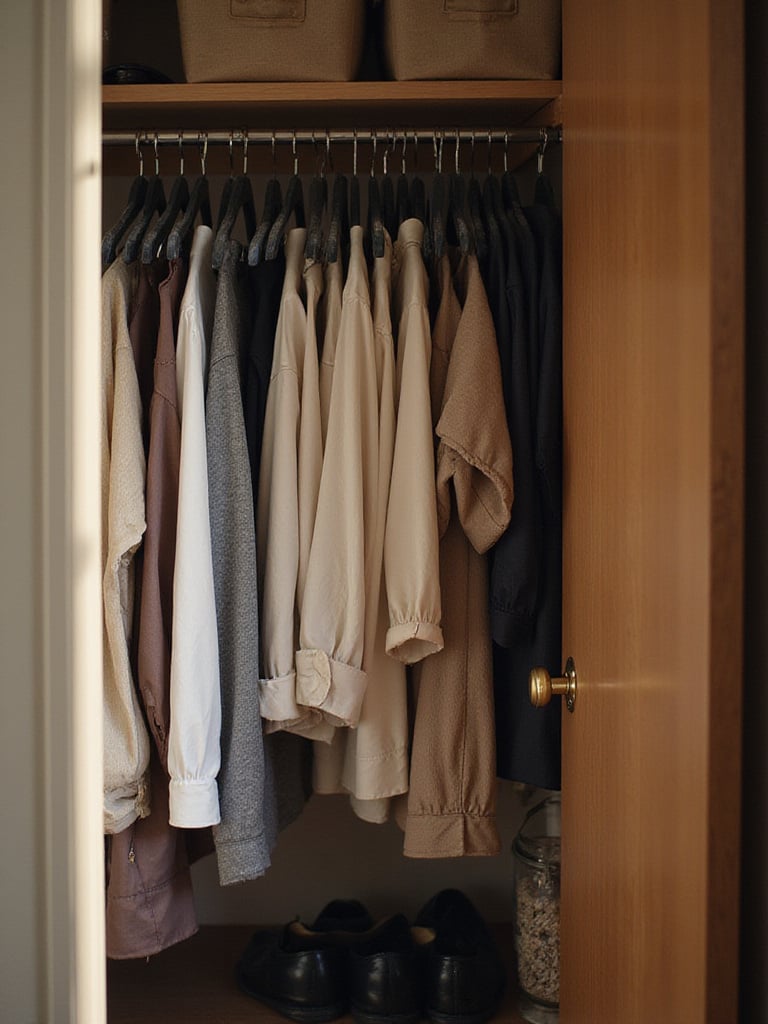
It’s not just about space, though. The uniform, streamlined look is incredibly calming to the eye. It turns your closet from a chaotic jumble into a little boutique. The velvet texture also grips clothing, so your silky blouses and wide-neck tops won’t be in a puddle on the floor anymore. It’s a small investment that makes the daily ritual of choosing your clothes a more peaceful and organized experience.
This is a perfect example of how mindful design is often about making small, incremental changes that have a huge cumulative effect on your daily life.
Every room has them—those funny little corners that become dead space, collecting dust or a stray laundry basket. Let’s stop seeing them as awkward and start seeing them as opportunities for a little moment of beauty or function.
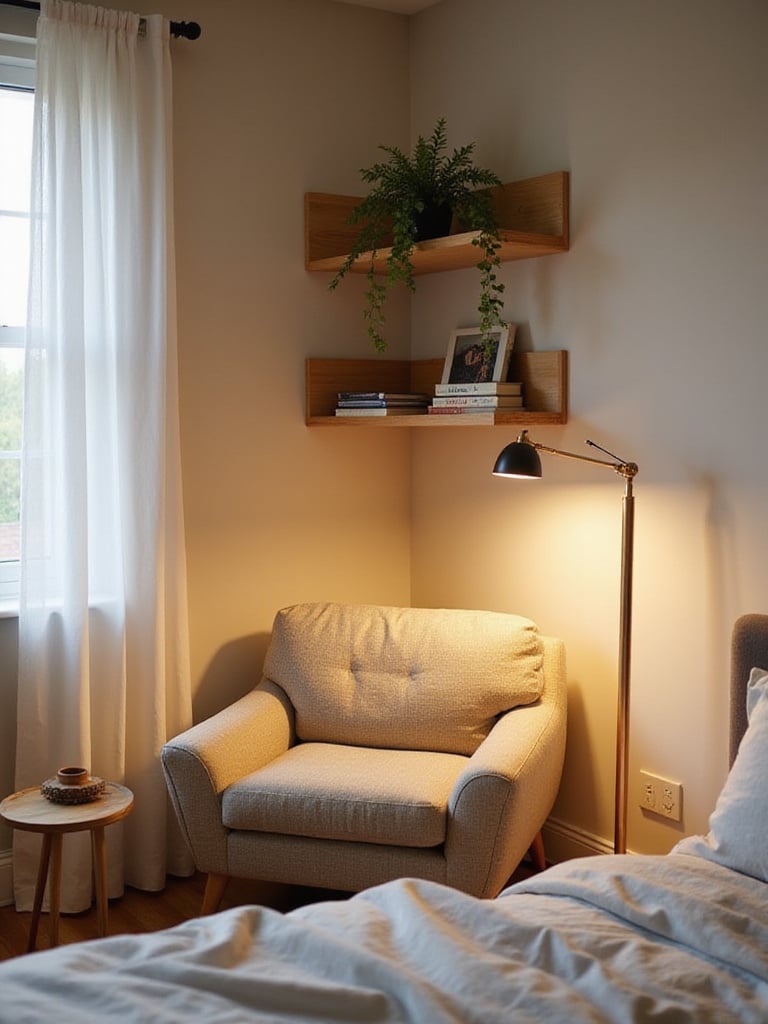
You could install a few triangular floating shelves for plants or books. Or find a slim corner desk. One of my favorite things to do is to create a tiny, dedicated meditation corner. All you need is a comfortable floor cushion, maybe a small, low shelf for a candle, and just like that, you’ve transformed a forgotten corner into a sacred space.
When we intentionally design these nooks, the whole room feels more complete and custom-tailored to our lives. No more wasted space, only possibility.
Here it is: the most underutilized surface in almost every single bedroom. The back of your door is a vertical plane of pure potential! With a simple over-the-door organizer, you can create a huge amount of storage without taking up an inch of floor space.

And we’ve come a long way from those basic plastic shoe bags. You can now find beautiful organizers in linen or canvas, with pockets of various sizes perfect for:
A few simple, elegant hooks can also turn this space into a home for your bathrobe or your go-to tote bag. The biggest mistake people make in small spaces is only looking at the main walls and floor. The real creative solutions are often hiding in plain sight.
The bed is the king or queen of the bedroom, and its size dictates everything else. In a small room, even a few inches can make a world of difference. Now, this isn’t for everyone, but if you’re sleeping solo, it’s worth asking: do you truly need that queen-sized bed?
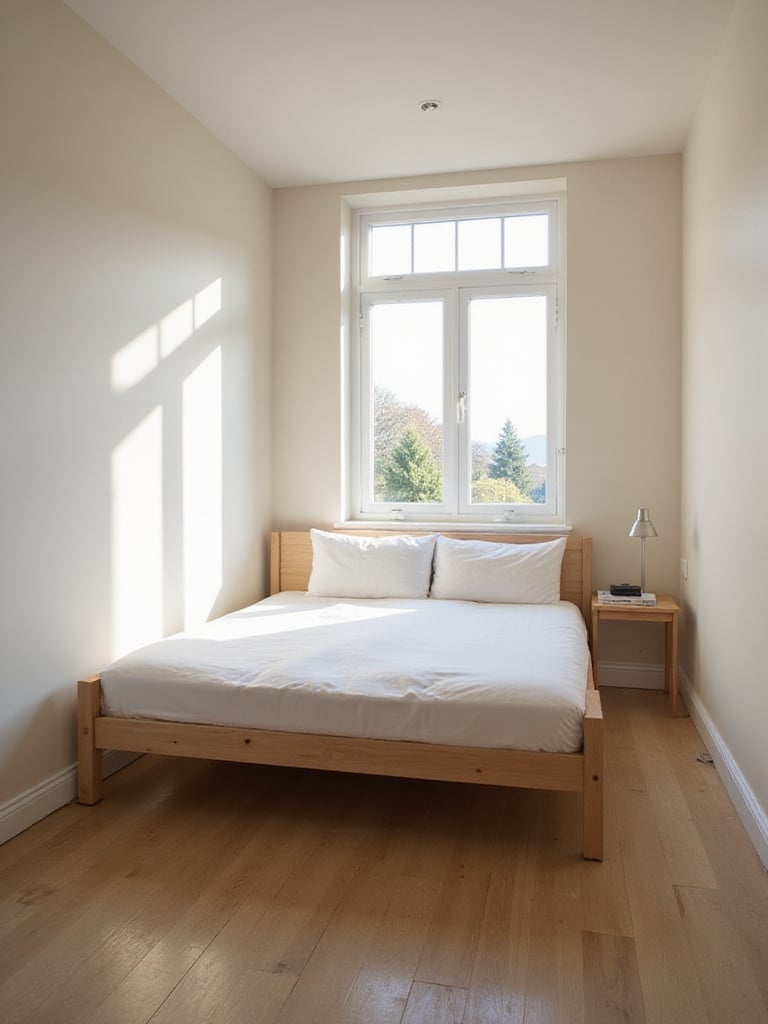
Moving from a queen to a full (or double) bed saves you 6 inches in width. That might not sound like much, but it can be the difference between being able to open a closet door fully or having space for a proper walkway. From my design experience, I’ve learned that proportion is everything. A slightly smaller bed that allows for good flow and complementary furniture creates a far more harmonious and restful room than a massive bed that crams the space.
It’s about prioritizing how the room functions as a whole, rather than just the size of one element.
Even in a tiny studio, you can create the feeling of different “rooms” or zones. A thoughtfully placed rug is the perfect tool for this. It can ground your sleeping area and make the whole space feel more intentional and designed.
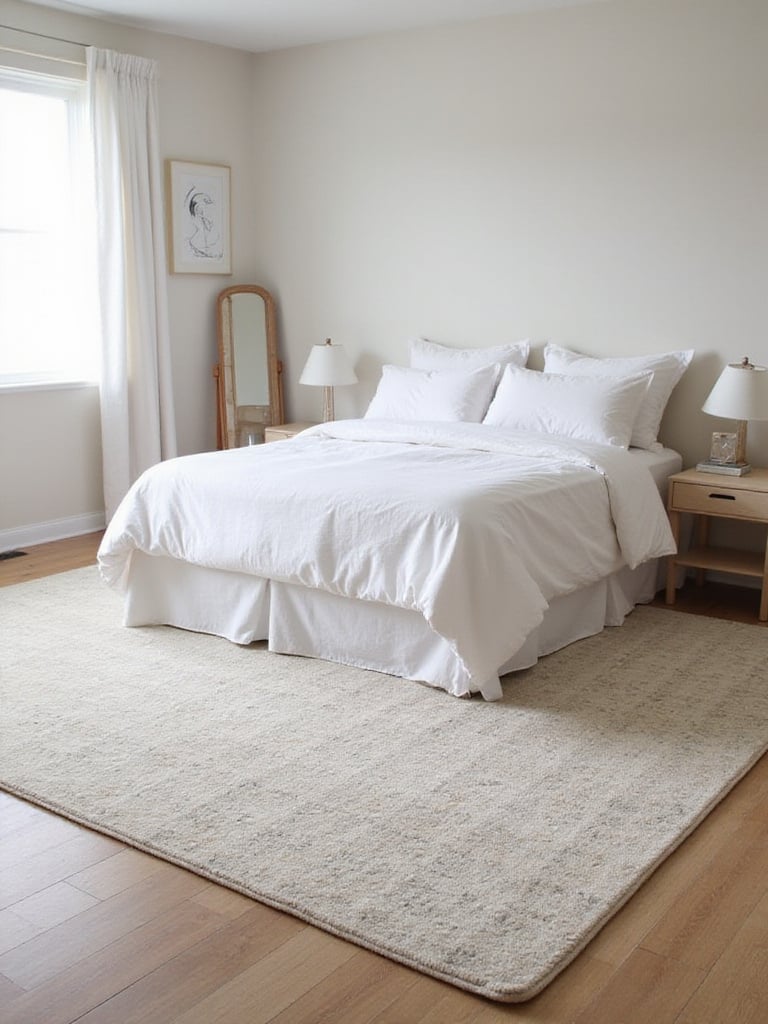
Try placing a rug so it extends about two feet on either side and at the foot of your bed. This creates a soft, warm landing for your feet in the morning and visually anchors the bed as the centerpiece of your sanctuary. If your bedroom also has to serve as a workspace, a small, separate rug under your desk can create a powerful psychological boundary. It helps you mentally “leave work” when you step off it.
A rug also adds a wonderful sensory layer—it dampens sound, adds warmth, and offers tactile pleasure. These are the subtle elements that truly deepen the mindful quality of a space.
Every room needs a touch of life, a connection to the natural world. But in a small bedroom, floor and surface space are at a premium. The solution? Look up! Hanging plants offer all the beauty and air-purifying benefits without taking up any precious real estate.
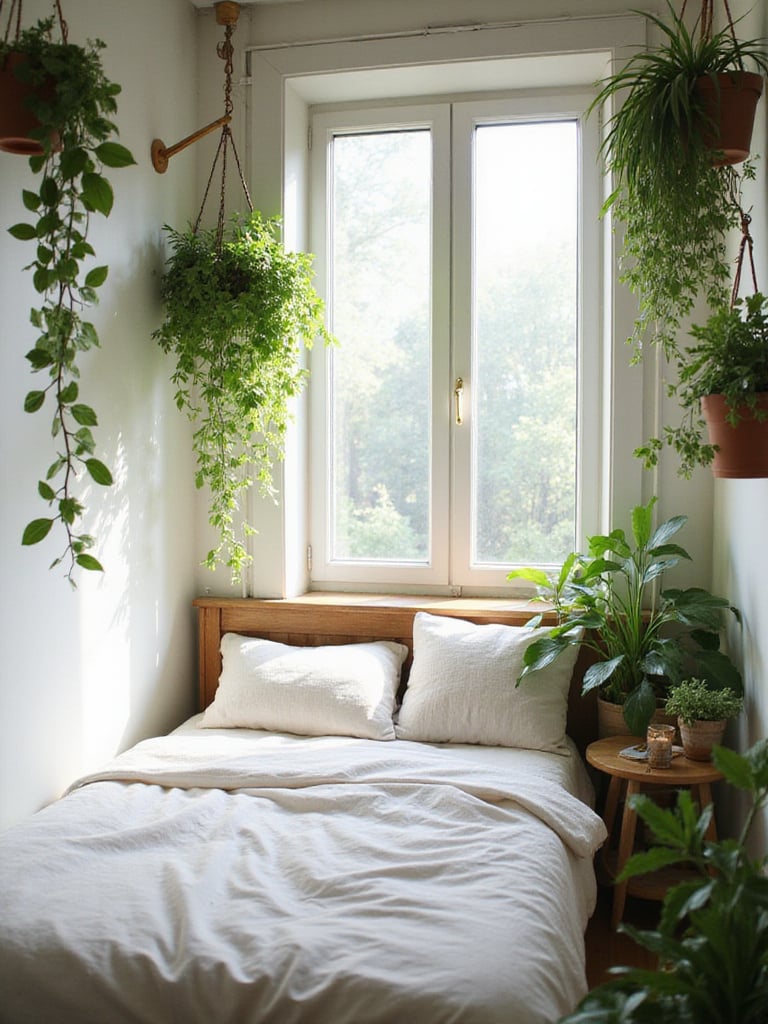
Drape a vining pothos from a hook in the corner or hang a spider plant near the window. They soften the hard architectural lines of a room and, according to the principles of biophilic design, their very presence can lower stress and support our wellbeing. There’s something so calming about seeing that splash of green, quietly growing.
From my own meditation practice, I know that connecting with nature—even in this small way—is a powerful grounding force. It reminds us that we are part of something bigger.
The fabrics you choose for your bedding and curtains have a huge impact on how a small room feels. Heavy, dark materials can absorb light and make a space feel cavelike and smaller. Lightweight, bright fabrics do the exact opposite—they create a sense of expansiveness and contribute to an airy, peaceful atmosphere.
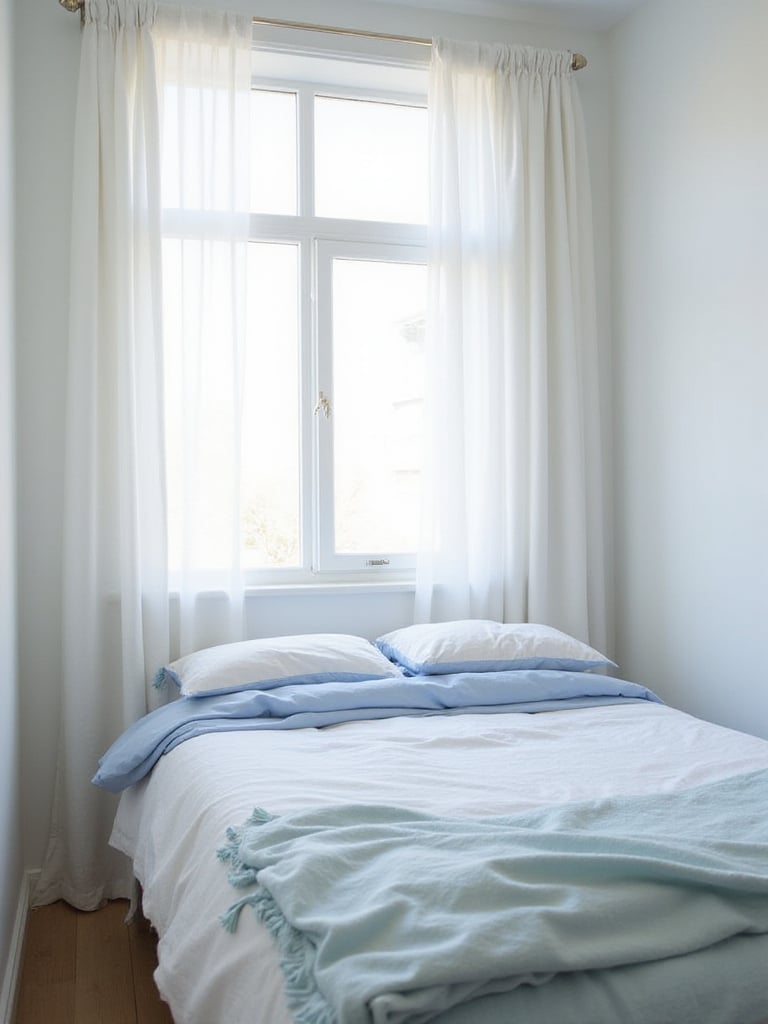
Look for natural fibers like linen, bamboo, or organic cotton. They have a beautiful, natural drape and a subtle luminosity that synthetic fabrics can’t replicate. You can still create coziness by layering different textures—a gauzy linen curtain with a soft knit throw on the bed—while keeping the color palette light and cohesive.
Imagine waking up as the morning light filters through a soft, white linen curtain. It’s a gentle, sensory experience that sets a peaceful tone for your entire day.
While simple fabric boxes are a good start, investing in proper, purpose-built drawers that roll out from under your bed is a fantastic upgrade for organization and ease.
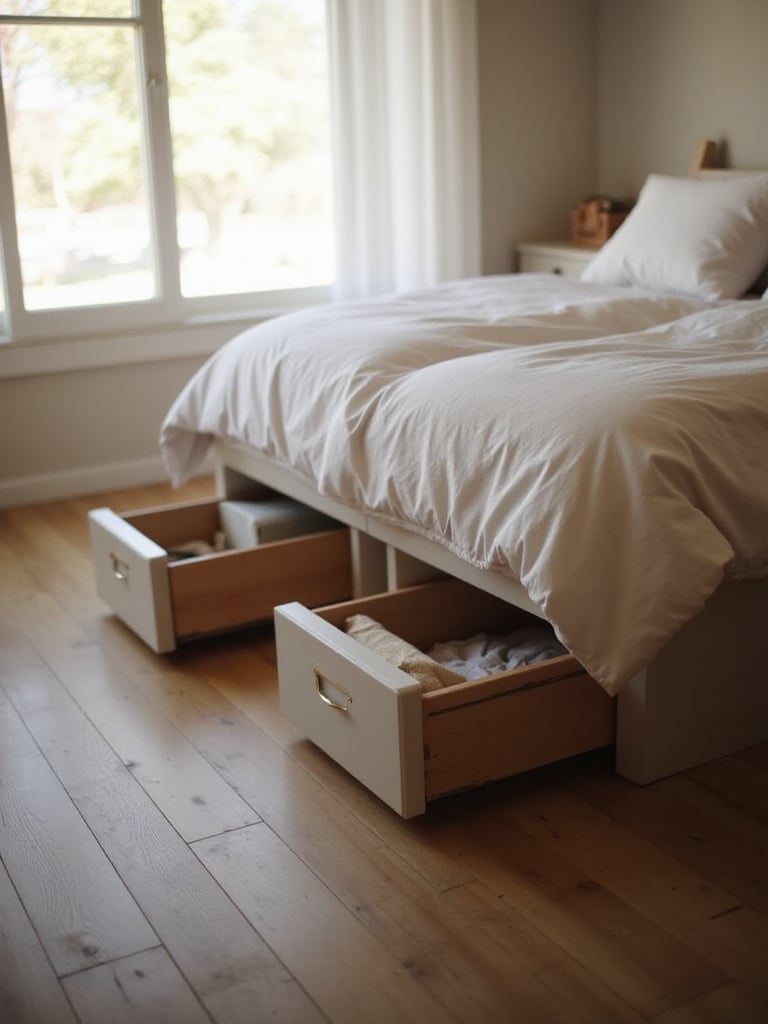
These units transform that hidden space into a fully functional, accessible dresser. Look for options on smooth-gliding wheels and with covers to keep dust out. Some bed frames come with them already built-in, which is ideal. I once worked with a client who was able to eliminate her entire dresser—a huge, bulky piece of furniture—by switching to a bed with four deep storage drawers. It completely changed the flow and feel of her room.
This is an investment in ease. Making your storage effortless to access means you’re more likely to keep things tidy, which reduces friction in your daily life.
Art is what makes a room personal, but scale is absolutely crucial in a smaller space. The right piece can create a beautiful focal point, but art that’s too large can feel oppressive, and a collection of tiny pieces can just look like clutter.
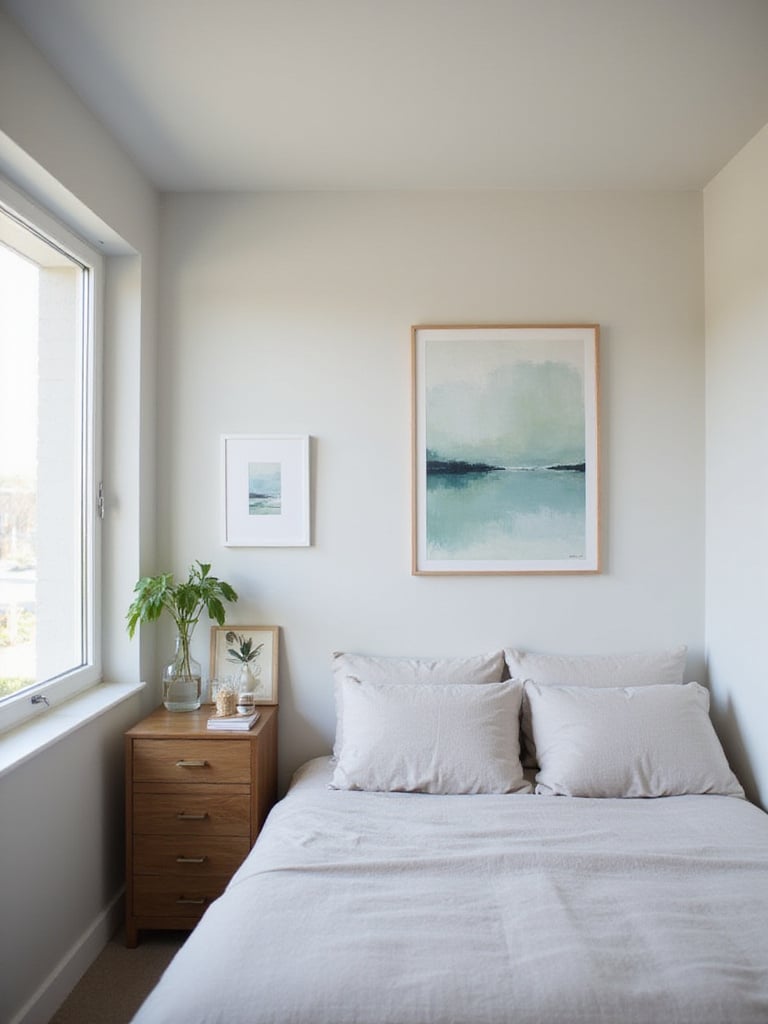
As a general guideline, a piece of art (or a tight grouping of pieces) hung above your bed should be about two-thirds the width of the headboard. This creates a sense of harmony and balance. In a small room, I often find that one larger, impactful piece feels more calming and expansive than a busy gallery wall.
Think of art as a window. What do you want to look at? Choose a piece that gives you a feeling of peace or spaciousness—a serene landscape, a soft abstract. It can become a visual mantra for your space.
This is the daily practice that maintains the sanctuary you’ve created. Clear surfaces are like a deep breath for a room. When your nightstand, dresser, and desk are relatively clear, the entire space feels calmer and more open.
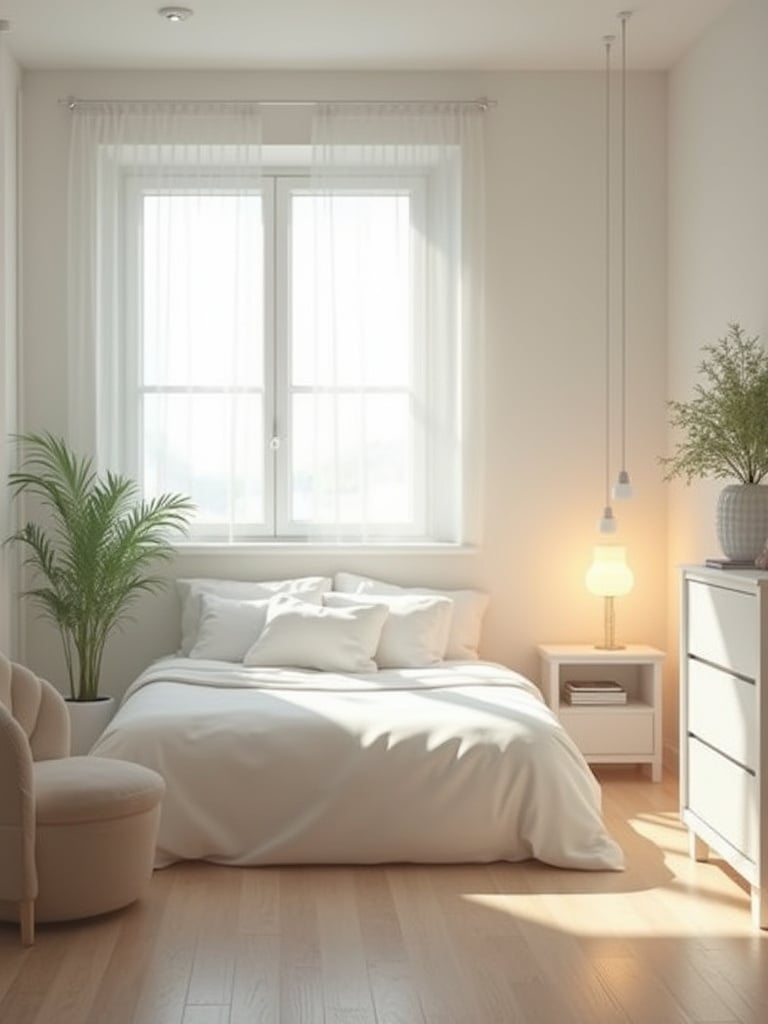
This doesn’t mean they have to be totally empty! It’s about intentional curation. Limit what you keep out to a few meaningful, beautiful items. A single lovely vase, one or two special books, a treasured object. This practice of editing allows the things you truly love to shine.
“The ability to simplify means to eliminate the unnecessary so that the necessary may speak.” – Hans Hofmann
This is so true for our homes. By clearing away the non-essential, you allow the things that hold real meaning and beauty to speak to your soul.
Hooks are the unsung heroes of organization in a small bedroom. They are incredibly efficient, offering a home for those in-between items that might otherwise end up on a chair or the floor.
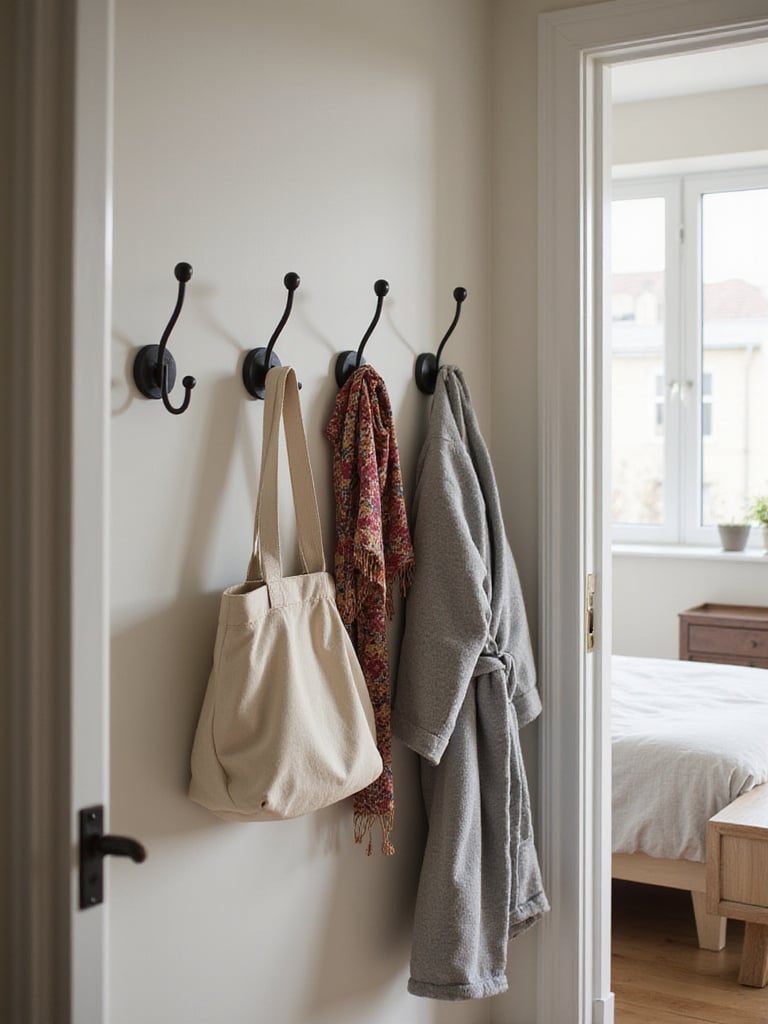
Install a row of beautiful, decorative hooks on a small strip of wall or on the back of your door. Use them for your favorite scarves, your tote bag, your robe, or the necklace you wear every day. You can even find gorgeous, sculptural hooks that look like art when they’re not in use. It’s about finding that perfect marriage of beauty and function.
The key is to make organization feel effortless and elegant, not like a chore. A well-placed hook is a tiny invitation to tidiness.
If you need a standalone dresser, think vertically instead of horizontally. A traditional low, wide dresser eats up a massive amount of floor space. A tall, narrow chest of drawers—often called a “semainier” or lingerie chest—provides a surprising amount of storage while occupying a much smaller footprint.
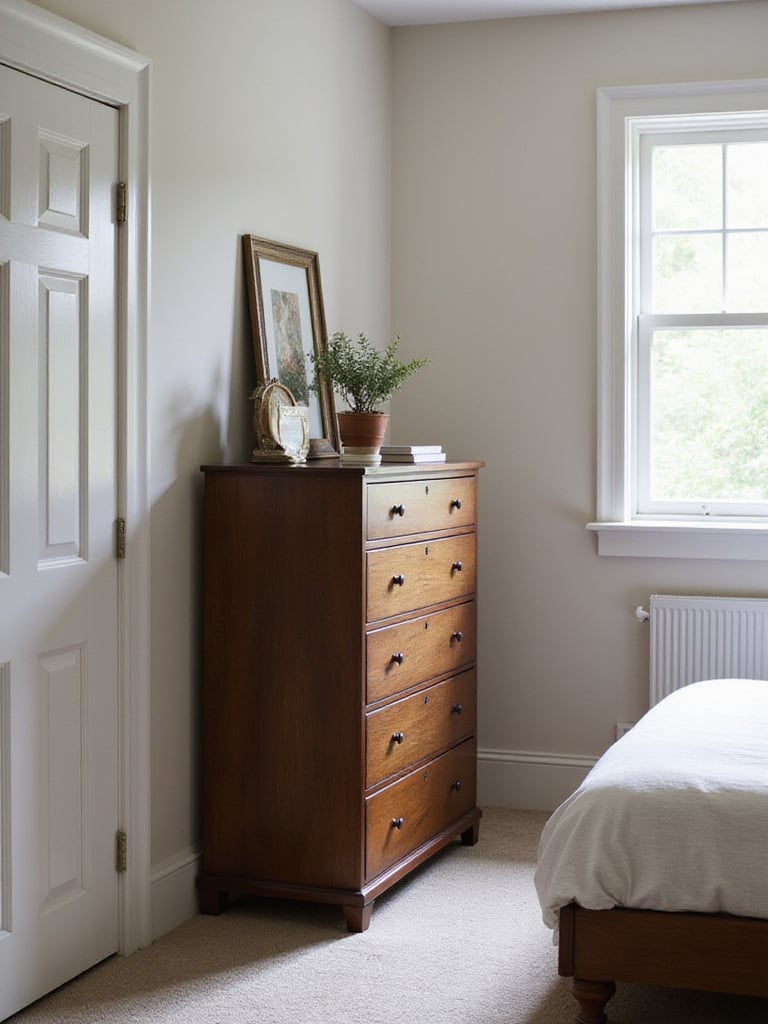
This shift in proportion works beautifully in small rooms because it draws the eye upward, creating that same feeling of lift we talked about earlier. It respects your precious floor space while still meeting your storage needs. From a design history perspective, these tall chests became popular in bustling European cities where living quarters were tight—a timeless solution to a common challenge.
This choice helps free up the floor, making your primary pathway through the room feel more generous and open.
Finally, before you move a single piece of furniture, let’s talk about flow. The most beautifully decorated room will feel uncomfortable if the layout is awkward. Thoughtful space planning ensures your room not only looks calm but feels calm to move through.
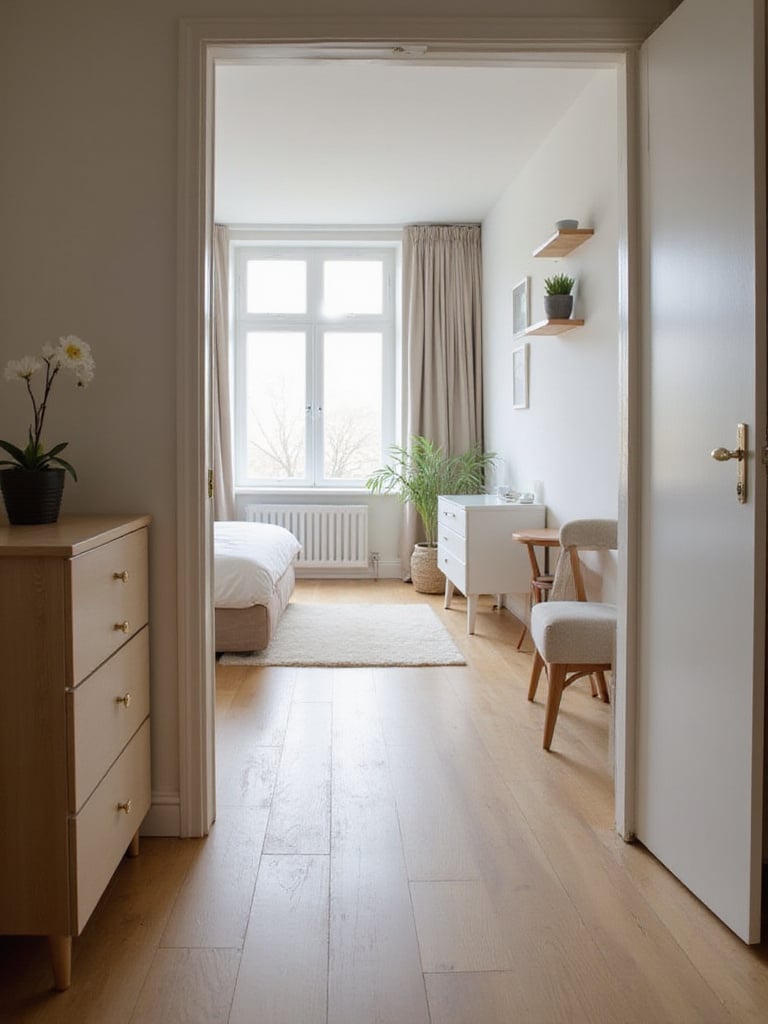
Take a piece of paper and sketch out your room, marking the doors and windows. Your main pathway, usually from the door to the far side of the bed, should be clear and at least 24-30 inches wide. Arrange your furniture to protect this path. Imagine your daily movements—getting out of bed, opening your closet, sitting at your desk. Make sure you leave enough clearance for drawers to open and doors to swing.
What I tell my meditation students is that a clear path in your room helps create a clear path in your mind. When your physical space supports your natural movements, it removes a layer of unconscious friction from your life, allowing you to move with more ease and grace.
As you can see, transforming your small bedroom isn’t really about finding clever storage hacks; it’s about a much deeper and more rewarding process of intentional living. It’s about curating your environment to reflect the peace you want to cultivate within yourself. Each of these ideas is a small step toward creating a room that feels spacious not just for your body, but for your mind and spirit.
The most serene and beautiful small bedrooms I’ve had the joy of designing all share a few core qualities: they hold only what is truly useful or deeply loved, they use every inch of space with creative intelligence, and they prioritize tranquility over passing trends. By approaching your bedroom with this sense of mindfulness, you are doing more than just decorating. You are building a sanctuary that will nurture you, a space that supports you from the moment you wake until you close your eyes at night. So start small, choose the idea that resonates most, and just begin. You deserve this peaceful haven.